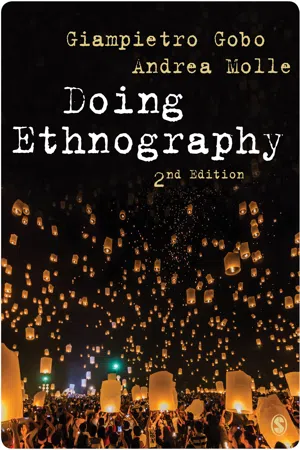
Doing Ethnography
Giampietro Gobo,Andrea Molle
- 352 páginas
- English
- ePUB (apto para móviles)
- Disponible en iOS y Android
Doing Ethnography
Giampietro Gobo,Andrea Molle
Información del libro
Doing Ethnography is invaluable reading for anyone collecting data through observation. Innovative and thought provoking, it is a refreshing take on ethnography stressing both academic rigor and practical necessity. It combines theoretical perspective with tangible action plans and walks you step-by-step through designing, conducting, and evaluating ethnographic research. The book skilfully introduces the varied tasks and decisions you need to consider before entering the fieldhelping you to avoid common mistakes and to conduct safe, ethical research. The redesigned Second Edition has cutting edge case studies and examples from across the social sciences and has an embedded awareness of the importance of digital research tools and social media. It also includes a detailed discussion of:
- Autoethnography
- Digital Ethnography
- Visual Ethnography
- Feminist Ethnography
- Managing and Analysing data
This is an ideal companion for every novice researcher.
Preguntas frecuentes
Información
Part One The Methodology
1 What Is Ethnography?
When Hermes took the post of messenger of the gods, he promised Zeus not to lie. He did not promise to tell the whole truth. Zeus understood. The ethnographer has not.Vincent Crapanzano, 1986: 53
Learning objectives

- To gain an understanding of ethnographic methodology.
- To grasp the differences between attitude, belief and behavior.
- To gain familiarity with the main elements of ethnographic methodology.
- To understand the advantages and drawbacks of ethnographic methodology.
- To appreciate the historical roots of its development.
- To identify the most important methodological differences between doing ethnography in sociology and anthropology.
1.1 Introduction
1.2 An overview of ethnography
SECONDARY ADJUSTMENTSThe first thing to note is the prevalence of make-do’s. In every social establishment participants use available artefacts in a manner and for an end not officially intended thereby modifying the conditions of life programmed for these individuals. A physical reworking of the artefact may be involved, or merely an illegitimate context of use [...] In Central Hospital many simple make-do’s were tacitly tolerated. For example, inmates widely used freestanding radiators to dry personal clothing that they had washed, on their own, in the bathroom sink, thus performing a private laundry cycle that was officially only the institution’s concern. On hard-bench wards, patients sometimes carried around rolled up newspapers to place between their necks and the wooden benches when lying down. Rolled-up coats and towels were used in the same way ... Older patients who were disinclined or unable to move around sometimes employed strategies to avoid the task of going to the toilet: on the ward, the hot steam radiator could be urinated on without leaving too many long-lasting signs; during twice-weekly shaving visits to the basement barber shop, the bin reserved for used towels was used as a urinal when the attendants were not looking ... In Central Hospital, toilet paper was sometimes ‘organized’; neatly torn, folded, and carried on one’s person, it was apologetically used as Kleenex by some fastidious patients. (Goffman, 1961: 207–9)SOCIAL DEATHWhen, in the course of a patient’s illness his condition is considered such that he is dying or terminally ill, his name is posted on the critical patients list ... Posting also serves as an internally relevant message, notifying certain key hospital personnel that a death may be forthcoming and that appropriate preparations for that possibility are tentatively warranted. In the hospital morgue, scheduling is an important requirement. Rough first drafts of the week’s expected work load are made, with the number of possible autopsies being a matter which, if possible, is to be anticipated and planned for. In making such estimates the morgue attendant consults posted lists from which he makes a guess as to the work load of the coming week. The posted list is also consulted by various medical personnel who have some special interest in various anatomical regions. County’s morgue attendant made it a practice to alert the ward physician that Doctor S. wanted to get all the eyes he could (Doctor S. was a research ophthalmologist). To provide Doctor S. with the needed eyes, the morgue attendant habitually checked the posted list and tried, in informal talk with the nurses about the patient’s family, to assess his chances of getting the family’s permission to relinquish the eyes of the patient for research. Apparently, when he felt he had located a likely candidate, a patient whose family could be expected to give permission at the time of death, he thus informed the pathologist, who made an effort, via the resident physician, to have special attention given to the request for an eye donation. (At several places in the hospital: on the admission nurse’s desk, in the morgue, in doctors’ lounges, and elsewhere, there were periodically placed signs that read ‘Doctor S. needs eyes’, ‘Doctor Y. needs kidneys’, etc.). (Sudnow, 1967: 72–3)
Exercise 1.1

- Your reactions to the two passages.
- Your emotional reactions to them.
- Have you ever thought such things could be happening in a hospital?
1.3 Defining ethnography
1.4 A definition of ethnography
- establishes a direct relationship with the social actors by
- staying in their natural environment
- with the purpose of observing and describing their behavior, and by
- interacting with them and participating in their everyday ceremonials and rituals
- learning their code (or at least parts of it) in order to understand the meaning of their actions, and
- collecting ethnographic notes in a rigorous and systematic way.
1.5 The gap between attitudes, beliefs and behavior
if, say the behaviorists, you wish to know what a person is doing, by all means refrain from asking him. His answer is sure to be wrong, not merely because he does not know what he is doing but precisely because he is answering a question and he will make the reply in terms of you and not in terms of the objective thing he is doing. (1924, quoted by Converse, 1987: 54)